Thinner, Flatter and Sharper Than Ever Before
With single vision lenses being the most popular eyeglass lens type worldwide, ZEISS’s ClearView Single Vision lenses have revolutionized standard single vision lenses by incorporating many attributes of complex freeform designs into both surfaced and stock lenses. These carefully crafted optics offer clear visuals from the center to periphery while being significantly flatter and thinner to improve overall aesthetics. An industry first, these innovative standard single vision lenses will certainly benefit both eyecare professionals and their patients alike.
Globally, 75% of people who wear eyeglass lenses purchase single vision lenses.[1] These are often stock lenses due to their low cost and speedy delivery for both the eye care professional and patient. In comparison to freeform-optimized lenses, standard single vision lenses are unable to unlock the full potential of precision. ZEISS ClearView lenses are engineered to give you many of the same benefits of freeform-optimized single vision lenses, but with the cost benefit of a standard single vision lens.
“Innovation is at the core of the ZEISS brand, and we are transforming the standard single vision lens market by bringing many aspects of freeform lens design to the single vision lens category in both surfaced and stock”
Jens Boy, President ZEISS Vision Care North America
The ZEISS ClearView Benefits
ZEISS ClearView lenses offer, on average, a three times larger zone of excellent clear vision and provide the wearer with more clarity from the lens center to the periphery. In addition, ZEISS ClearView lenses are, on average, 49% flatter across all prescriptions and up to 16% thinner compared to typical spherical single vision lenses.[2] [3]
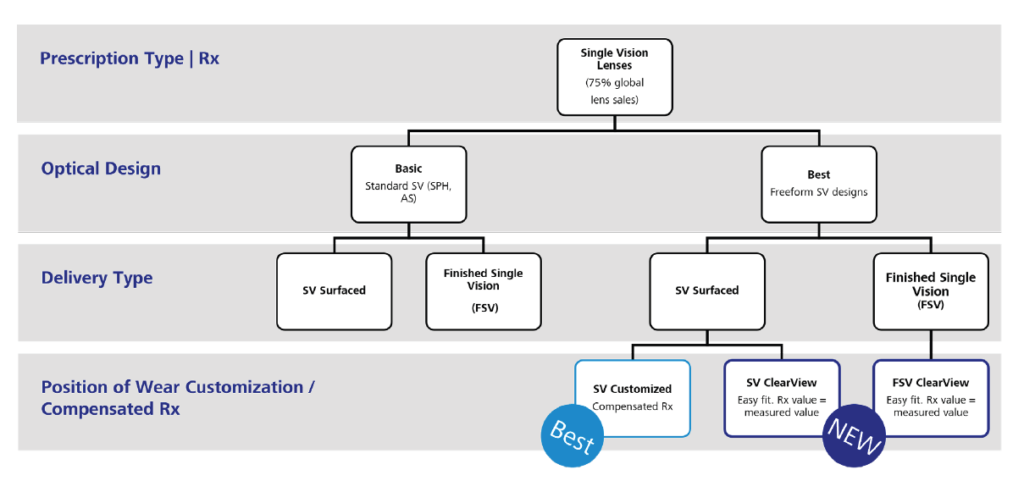
Standard single vision lenses do not traditionally have great peripheral optics
Generally, standard SV lenses are evaluated based on their material index, anti-reflective coatings, UV and blue light blocking abilities or how thin and flat they appear. The lens power is typically measured from the middle of the lens with vision clarity and optical performance across the entire lens being often neglected. Whether a stock FSV or SV surfaced lens, the truth is that traditional SV lenses do not offer superior peripheral optics. With the restrictions of ordinary SV lens designs, the ambition to make them flatter and thinner further compromises their optical performance particularly in the periphery of each lens.
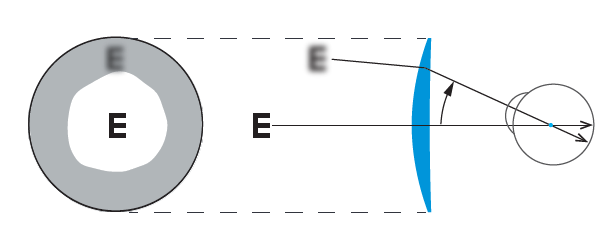
Patients want clarity across the entire lens
When single vision wearers were asked about the importance of different lens features (Figure 2)[4], 100% clearly stated that it was extremely or very important to them that their lenses offer comfortable vision across the entire lens. 90% stated that it was extremely or very important for them to see clearly across the entire lens.
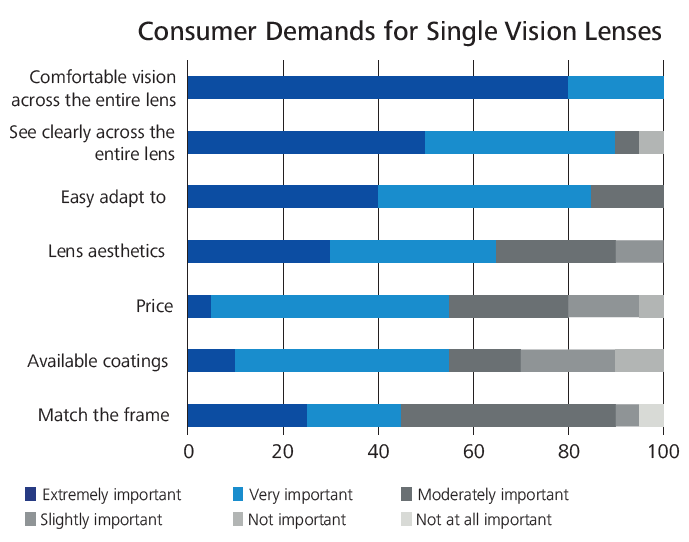
When questioned on the importance of different lens features (Figure 2)[4], every single vision wearer (100%) emphasized that it was absolutely essential to have lenses which provide comfortable and clear vision across the entire lens surface.
The evolution of single vision lens designs
So why is it that many SV lenses show underwhelming performance in regards to their peripheral optics? The answer is found within the design of the lens itself. While multiple forms can be used to obtain a central power for any given lens, different designs lead to varied aesthetics and wearing comfort, as well as having a massive influence on optical performance – especially in the lens periphery. Therefore, by optimizing lens design complexity (Figure 3), broader optical effectiveness across an entire lens may be accomplished.
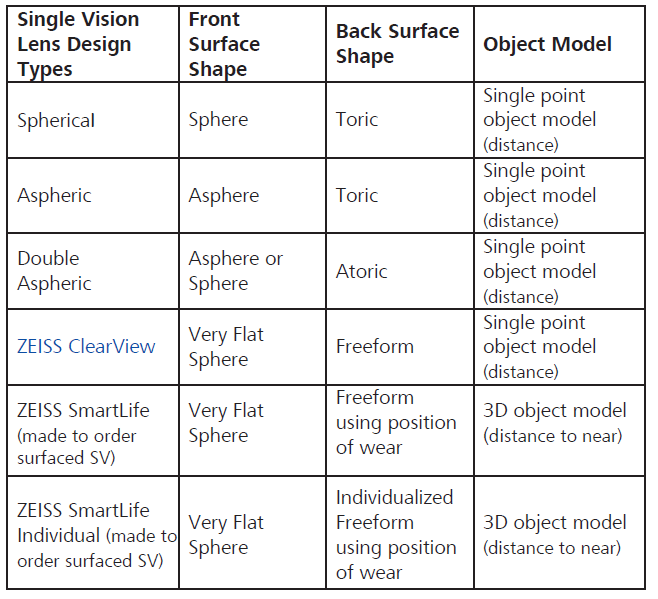
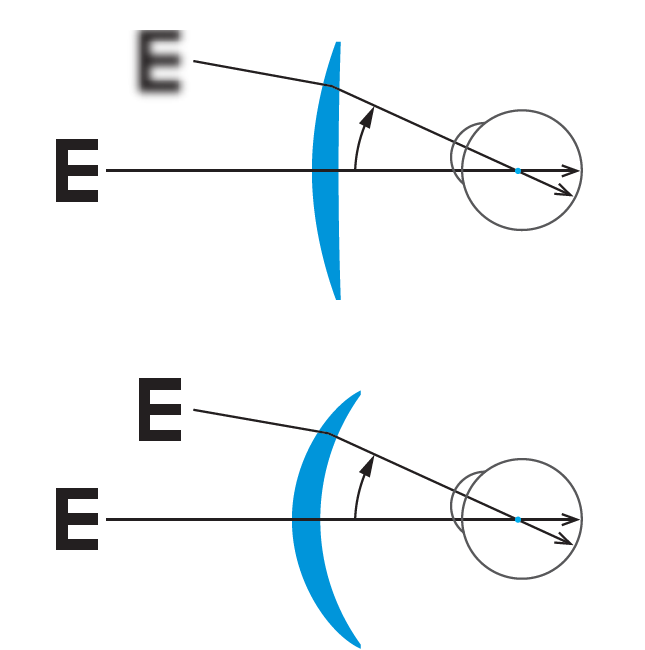
Single Vision lenses
ZEISS wanted to redefine the playing field and ask why standard single vision lenses couldn’t provide numerous sight benefits similar to freeform lens design. Consequently, they set out on a mission to challenge this notion for many single vision wearers.
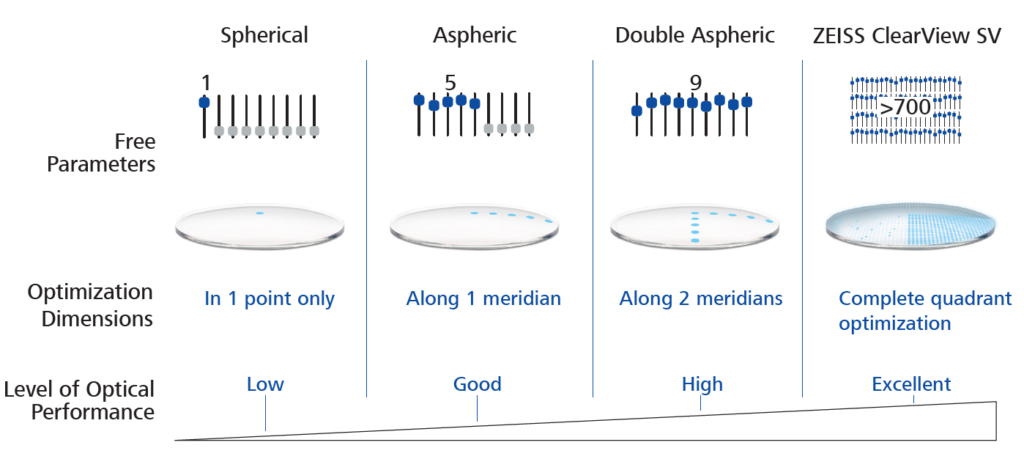
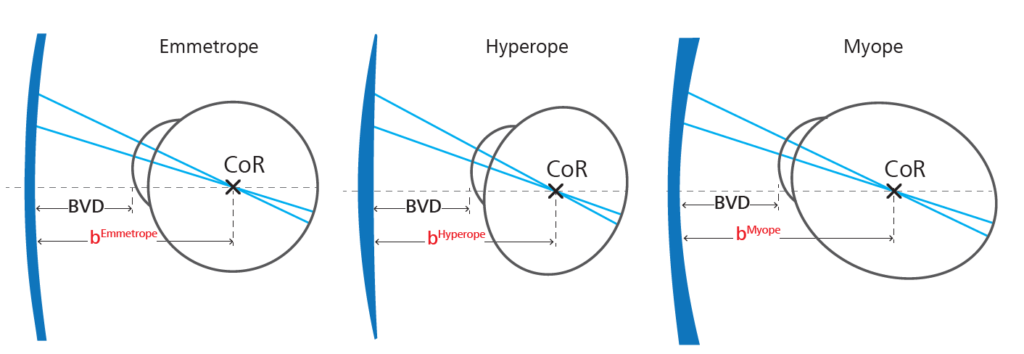
ZEISS has found a way to make complex freeform lens designs more accessible in standard single vision lenses, with no need for compensated Rx values, in both FSV and surfaced SV lenses. The advanced freeform design used by ZEISS ClearView SV is optimized point-by-point on the lens surface using 700 different parameters across one quadrant of the lens. The lens power is optimized and then replicated twice over to cover all surfaces of the lens, ensuring maximum precision. The outcome is a remarkable SV lens that is thinner and flatter, but also provides exceptional optics – boasting clear visuals in the middle of the lens all the way to its edges.

ClearForm® technology by ZEISS
ZEISS ClearView SV lenses can be delivered by two methods.
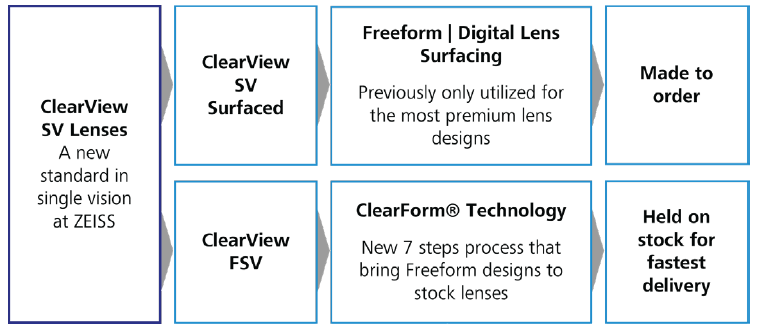
I. ZEISS ClearView SV lenses are made to order and crafted with an innovative Freeform Rx lens surfacing process that was once exclusive to premium lenses. This equipment is gaining widespread acceptance in the ophthalmic sector, but its benefits can only be realized when paired with a more advanced freeform lens design such as ZEISS ClearView. Without it, very little value comes from designing SPH or AS lenses.
II. ZEISS ClearView FSV lenses are pre-manufactured for immediate delivery or are in-stock at customer locations for a quicker delivery to patients. These remarkable lenses are the result of ZEISS’s revolutionary ClearForm® technology, which brings a freeform lens design to life in a finished stock lens – an endeavor that could only be achieved through extensive collaboration among our ZEISS global centers of excellence. From lens design and industrial metrology in ZEISS’ German headquarters to freeform mold generation at the European glass mold making center of excellence to a collaboration between international R&D and manufacturing locations for casting development.
A 3X larger zone of excellent vision clarity.
To ensure that ZEISS ClearView FSV lenses provide the exceptional optical performance they were designed for, their optical performance was studied using the advanced ZEISS Vision Clarity Simulation.

ZEISS ClearView FSV lenses provide an average of 3X and up to 5 times more extensive zones of visual clarity for single vision wearers in comparison to traditional ZEISS Aspheric FSV lenses, as confirmed by this comprehensive analysis.[8] On average, ZEISS ClearView FSV lenses provide an impressive 3.1 times larger area with excellent clear vision versus the preceding ZEISS AS FSV lenses. For higher myopic prescriptions this number can reach up to 4.0x while for those with hyperope prescriptions it can be as high as 5.1x.
Thinner Lenses
With ZEISS ClearView SV lenses, wearers can experience excellent vision clarity in a lens that is flatter and thinner than conventional lenses that rely on steeper base curves to provide acceptable optical performance. Freeform SV lens designs with point-by-point optimization provide a thickness reduction at the lens edge for minus lenses.
ZEISS ClearView SV lenses are thinner and flatter, provide outstanding performance, surpassing what is achievable through conventional lenses with steep base curves. By using point-by-point optimization in the Freeform SV lens designs, they create a reduction in thickness at the edge of minus lenses as well.

When it comes to plus lenses, which are generally thicker in the middle of the lens, 1.60 ZEISS ClearView FSV is on average 8% thinner at its center and up to 13%, particularly for prescriptions that exceed +5.00 D sphere power. This comparison has been made when contrasted with 1.60 ZEISS SPH FSV lenses. (Figure 9).[3]
Flatter Lenses – with no optical compromise
ZEISS ClearView SV technology allows wearers to have flatter, more attractive lenses with little compromise in peripheral vision clarity, thanks to its reduced curvature. On average, FSV forms are 34% flatter than ZEISS SPH 1.6 FSV across all prescriptions; minus range can be up to 49% flatter and plus range up to 25%. (Figure 9)[3]
All in all, ZEISS ClearView FSV lenses are significantly flatter than typical SPH SV lenses by 34%, and up to 16% thinner. This ensures the highest caliber of vision clarity.
ZEISS ClearView SV – same fitting as for Aspheric Single Vision
To ensure superior performance, the optical center of your lenses should be centered on the wearer’s pupil. To guarantee this result, measure the fitting height to the pupil according to a horizontal viewing line and reduce it by 0.5 mm for each degree of pantoscopic tilt.
Single vision wearers can now enjoy a distinct, larger view of their lenses for an even more comfortable and satisfying experience with ZEISS ClearView lenses.
Good sight makes for better learning. Find out how vision impacts learning and why annual eye exams are important.
Already a ZEISS customer? Just ask your ZEISS Business Development Representative for more information.
Not yet a customer? Find out more about becoming one.
Are you a patient? Find an eye doctor with ZEISS lenses near you.
References
[1] Strategy with Vision (September 2020). World Lens and Frame Demand Study, 2020.
[2] Measurements of lens thickness on 1.60 ZEISS ClearView FSV lenses compared to ZEISS spherical FSV lenses over a range of prescriptions (-5, -3, -1, +1, +3, +5 D with and without cyl -2 D). Maximum reduction of 16% for center thickness of +5.00/-2.00. Quantitative analyses by Technology & Innovation, Carl Zeiss Vision GmbH, DE, 2020.
[3] Measurements of lens flatness (base curve) on 1.60 ZEISS ClearView FSV lenses compared to ZEISS Spherical FSV lenses. Average of -5, -3, -1, +1, +3, +5 D with and without cyl -2 D. Maximum reduction of 49% of -5.00 D with and without -2 D cyl for minus lenses. Maximum reduction of 25% of 5.00 D with and without -2 D cyl for plus lenses. Quantitative analyses by Technology & Innovation, Carl Zeiss Vision GmbH, DE, 2020.
[4] Study participants were asked to rate how important different aspects (“price”, “to see clearly across the entire lens”, “easy to adapt to”, “comfortable vision across the entire lens”, “aesthetics”, “available coatings”, “matches the frame”) are for them, when choosing new spectacle lenses. Wearer trial comparing 1.60 ZEISS ClearView FSV and 1.60 ZEISS AS FSV in a laboratory setup and in everyday life. N=20 study participants. Technology & Innovation, Carl Zeiss Vision GmbH, DE, 2020.
[5] Measurements of lens thickness on 1.60 ZEISS ClearView FSV lenses compared to ZEISS spherical FSV lenses over a range of prescriptions (-5, -3, -1, +1, +3, +5 D with and without cyl -2 D). Maximum reduction of 16% for center thickness of +5.00/-2.00. Quantitative analyses by Technology & Innovation, Carl Zeiss Vision GmbH, DE, 2020.
Clear Vision is best resulit Nice love zeiss i use antivirus coating
Thanks!
Which distributors of stock lenses and which labs doing surfaced lenses are providing ClearView lenses?
Thank you
As editor of OPTOMETRY TODAY, I invite you to advertise ClearView Lenses in September 2023 issue of the quarterly journal, eCopy of June 20023 issue of which is available for your kind perussal.